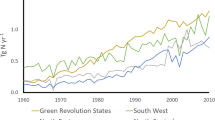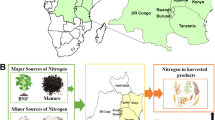Abstract
While increasing population and changing food preferences have changed agriculture in some East Asian countries to high input systems with greater use of fertilizer nitrogen and greater numbers of animals, the changes and the effects on the environment in the different countries have varied considerably. Many areas still do not use sufficient nitrogen to maximize crop yields. In China, fertilizer nitrogen input has increased from 0.54 Tg in 1961 to 28 Tg in 2005, and the animal population increased dramatically, from 27 to 1,013 million. As a result 13 Tg N was lost to the environment in 2005 as nitrous oxide, ammonia or nitrate. In Mongolia, no fertilizer nitrogen was recorded as having been used until 1970, and current use is only ∼4 Gg. The animal population has increased from 23 million in 1961 to 28 million in 2005 and adverse effects on the environment are small (96 Gg N lost). However, a combination of over-ploughing and overgrazing has resulted in soil erosion from wind and rain in both countries and loss of soil nitrogen. These and other effects of changing agricultural systems on the nitrogen cycle in East Asian countries and some approaches to reduce the impact of nitrogen on the environment are reported in this paper.



Similar content being viewed by others
References
Ahmed S (1996) Agriculture-fertilizer interface in the Asian and Pacific Region: issues of growth, sustainability, and vulnerability. Extension Bulletin. Food and Fertilizer Technology Center, Taipei
Bouwman AFD, Lee S, Asman WAH, Dentener FJ, Van der Hoek KW, Olivier GJ (1997) A global high-resolution emission inventory for ammonia. Global Biogeochem Cycles 11:561–587
Brown LR (2001) Dust bowl threatening China’s future In: Brown LR, Flavin C, French H et al (eds) Worldwatch institute report, May 23. WW Norton & Company, New York
Bujidmaa B, Enkhman S (2005) The nitrogen component monitoring and emissions in Mongolia. In: Proceedings of the 3rd international nitrogen conference. Science Press, Monmouth Junction, New Jersey, USA, pp 721–724
Buresh R, Peng SB, Huang JL, Yang JC, Wang G.H, Zhong XH, Zou YB (2004) Rice systems in China with high nitrogen inputs. In: Mosier AR, Syers JK, Freney JR (eds) Agriculture and the nitrogen cycle. Island Press, Washington, DC, pp 143–153
Cai GX (1997) Ammonia volatilization. In: Zhu ZL, Wen QX, Freney JR (eds) Nitrogen in soils of China. Kluwer Academic Publishers, Dordrecht, The Netherlands, pp 193–213
Chen JS, Gao XM, Xia XH, He DW (1999) Nitrogen pollution of Yangtze River. Environ Sci 18:289–293, (in Chinese)
Chuluun T, Ojima D (1999) Climate and grazing sensitivity of the Mongolian rangeland ecosystem. http://www.nrel.colostate.edu/projects/lutea/chuluun_poster.htm
Chuluun T, Ojima D (2002) Land use change and carbon cycle in arid and semi-arid lands of East and Central Asia. Sci China (Series C) 45:48–54
Dobermann A, Cassman KG (2004) Environmental dimensions of fertilizer nitrogen: what can be done to increase nitrogen use efficiency and ensure global food security? In: Mosier AR, Syers JK, Freney JR (eds) Agriculture and the nitrogen cycle. Island Press, Washington, DC, pp 261–278
Duan S, Zhang S, Huang H (2000) Transport of dissolved inorganic nitrogen from the major rivers to estuaries in China. Nutr Cycl Agroecosyst 57:13–22
FAO (Food, Agriculture Organization) (2003) Fertilizer use by crop in the democratic people’ s Republic of Korea. First version. FAO, Rome
FAO (Food and Agriculture Organization) (2007) FAOSTAT database collections. http://www.faostat.fao.org. FAO, Rome
Howarth RW, Billen G, Swaney D, Townsend A, Jaworski N, Lajtha K, Downing JA, Elmgren R, Caraco N, Jordan T, Berendse F, Freney J, Kudeyarov V, Murdoch P, Zhu Z (1996) Regional nitrogen budgets and riverine N & P fluxes for the drainages to the North Atlantic Ocean: natural and human influences. Biogeochemistry 35:75–139
IFA (International Fertilizer Industry Association) (2002) Fertilizer use by crops. 5th edn. IFA, IFDC, IPI, PPI, FAO, Rome
IFA (International Fertilizer Industry Association) (2007) http://www.fertilizer.org/ifa/
IPCC (Intergovernmental Panel on Climate Change) (1997) Revised 1996 IPCC guidelines for national greenhouse gas inventories. The Organization for Economic Cooperative Development, Paris
Jarvis SC, Scholefield D, Pain B (1995) Nitrogen cycling in grazing systems. In: Bacon PE (ed) Nitrogen fertilization in the environment. Marcel Dekker Inc, New York, pp 381–419
Jin X, Liu S, Zhang Z et al (1995) Lakes in China—Research of their environment, vols 1–3. China Ocean Press (in Chinese)
Kumazawa K (2002) Nitrogen fertilization and nitrate pollution in groundwater in Japan: present status and measures for sustainable agriculture. Nutr Cycl Agroecosyst 63:129–137
Lian L (2002) Temporal and spatial distribution characteristics and analysis of causes of sand-dust storm s in the North of China. Ziran Zazhi 24:335–338 (in Chinese)
Liang Q (2002) Dust storm coming again. Meteorology 3:2–6
Mishima S (2001) Recent trend of nitrogen flow associated with agricultural production in Japan. Soil Sci Plant Nutr 47:157–166
Mishima S (2002) The recent trend of agricultural nitrogen flow in Japan and improvement plans. Nutr Cycl Agroecosyst 63:151–163
Misselbrook TH, Chadwick DR, Pain BF, Headon DM (1998) Dietary manipulation as a means of decreasing N losses and methane emissions and improving herbage N uptake following application of pig slurry to grassland. J Agric Sci 130:183–191
Mosier AR (2001) Exchange of gaseous nitrogen compounds between terrestrial systems and the atmosphere. In: Follett RF, Hatfield JL (eds) Nitrogen in the environment: sources, problems, and management. Elsevier Science B.V., Amsterdam, pp 291–309
Mosier AR, Zhu ZL (2000) Changes in patterns of fertilizer nitrogen use in Asia and its consequences for N2O emissions from agricultural systems. Nutr Cycl Agroecosyst 57:107–117
Mosier AR, Syers JK, Freney JR (2004) Agriculture and the nitrogen cycle: assessing the impacts of fertilizer use on food production and the environment. Island Press, Washington, DC
Mosier A, Kroeze C, Nevison C, Oenema O, Seitzinger S, Cleemput O (1998) Closing the global N2O budget: nitrous oxide emissions through the agricultural nitrogen cycle. Nutr Cycl Agroecosyst 52:225–248
Mosier AR, Bleken MA, Chaiwanakupt P, Ellis EC, Freney JR, Howarth RB, Matson PA, Minami K, Naylor R, Weeks KN, Zhu Z (2002) Policy implications of human-accelerated nitrogen cycling. Biogeochemistry 57/58:477–516
Nishio M (2001) Analysis of the actual state of nitrogen application in arable farming in Japan. Jpn J Soil Sci Plant Nutr 72:513–521, (In Japanese with English summary)
Ojima DS, Tieszen L, Chuluun T, Belnap J, Dodd J, Chen ZZ (1999) Factors influencing production systems and soil carbon of the Mongolian Steppe. http://www.nrel.colostate.edu/projects/lutea/dennis_poster.htm
Shen ZL, Liu Q, Zhang SM, Miao H, Zhang P (2003) A nitrogen budget of the Changjiang River catchment. Ambio 32:65–69
Smil V (1999) Nitrogen in crop production: an account of global flows. Global Biogeochem Cycles 13:647–662
Sun S, Zhang C (2000) Nitrogen distribution in the lakes and lacustrine of China. Nutr Cycl Agroecosyst 57:23–31
Van der Hoek KW (1998) Nitrogen efficiency in global animal production. Environ Pollut 102:127–132
Xi CF (1998) Soils of China. China Agricultural Press, Beijing (in Chinese), pp 1–1253
Xi CF et al (1990) Soils of China. China Agriculture Publishing House, Beijing, (in Chinese)
Xing G, Cao Y, Shi S, Sun G, Du L, Zhu J (2001) N pollution sources and denitrification in waterbodies in Taihu Lake region. Sci China (Series B) 44:304–314
Xu F, Guo S, Zhang Z (2002) Soil erosion in China based on the 2000 national remote sensing survey. J Geograph Sci 12:435–443
Yagi K, Minami K (2005) Challenges of reducing excess nitrogen in Japanese agroecosystems. Sci China C, Life Sci 48:928–936
Yan X, Akimoto H, Ohara T (2003) Estimation of nitrous oxide, nitric oxide and ammonia emissions from croplands in East, Southeast and South Asia. Global Change Biology 9:1080–1096
Zhang Q, Zhao X, Zhang Y, Li L (2002) Preliminary study of sand-dust storm disaster and countermeasures in China. Chinese Geograph Sci 12:9–12
Zhao H, Zhao X, Zhang T, Zhou R (2002) Changes of soil environment and its effects on crop productivity in desertification process of sandy farmlands. J Soil Water Conserv 16:1–4
Zhu ZL (1997) Fate and management of fertilizer nitrogen in agro-ecosystems. In: Zhu ZL, Wen QX, Freney JR (eds) Nitrogen in soils of China. Kluwer Academic Publishers, Dordrecht, The Netherlands, pp 239–279
Zhu ZL, Chen DL (2002) Nitrogen fertilizer use in China-contributions to food production, impacts on the environment and best management strategies. Nutr Cycl Agroecosyst 63:117–127
Zhu Z, Liu S (1989) Desertification and its control in China. Science Press, Beijing
Zhu ZL, Xiong ZQ, Xing GX (2005) Impacts of population growth and economic development on the nitrogen cycle in Asia. Sci China C, Life Sci 48:729–737
Author information
Authors and Affiliations
Corresponding author
Rights and permissions
About this article
Cite this article
Xiong, Z.Q., Freney, J.R., Mosier, A.R. et al. Impacts of population growth, changing food preferences and agricultural practices on the nitrogen cycle in East Asia. Nutr Cycl Agroecosyst 80, 189–198 (2008). https://doi.org/10.1007/s10705-007-9132-4
Received:
Accepted:
Published:
Issue Date:
DOI: https://doi.org/10.1007/s10705-007-9132-4




